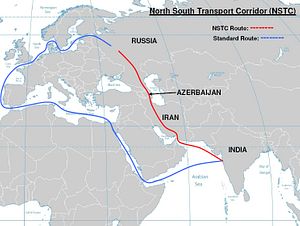The Foreign Trade Policy of India, 2015-20, has highlighted the importance of the International North-South Transport Corridor (INSTC) in expanding India’s trade and investment links with Central Asia. The INSTC is a multi-modal trade transport network that includes rail, road, and water transport from Mumbai in India via Bandar Abbas in Iran to Moscow in Russia. It could be used to explore further options for developing connectivity with other countries such as Turkey and in Eastern Europe.
For India, the INSTC looks to be a trade corridor of tremendous promise that could help the country develop its economic and strategic importance in Eurasia and Central Asia. It could facilitate India’s economic integration with Eurasian economies and other countries in surrounding regions.
The INSTC has particular economic and strategic relevance to India given the increasing regional ambitions of China through its One Belt, One Road Initiative. The proposed INSTC trade corridor could help India secure its interests in Central Asia and beyond.
First, the INSTC would substantially reduce the cost of transporting goods from India to Eurasia and surrounding regions, because it is shorter than the existing routes. A study by the Federation of Freight Forwarders’ Associations in India showed that the proposed INSTC would slash transit time and cost, and would enable the seamless movement of goods from India to Russia and surrounding countries. Specifically, the corridor would be 30 percent cheaper and 40 percent shorter than the current route via St. Petersburg to Moscow.
Second, India is expected to negotiate a comprehensive economic partnership agreement with the Eurasian Economic Union, which consists of Belarus, Kazakhstan, Kyrgyzstan and Russia, with Armenia likely to join. This agreement would help India expand its economic, trade and investment opportunities in this region. It would be easier to access these markets through the INSTC and it would boost the competitiveness of India’s trade.
Third, India is already the world’s fourth largest energy consumer, and its demand for energy is expected to increase significantly. Central Asia has abundant natural resources, including petroleum, natural gas and uranium, which could meet India’s energy needs. The region also offers abundant deposits of fertilizer inputs such as potash. Meanwhile, these sectors are becoming increasingly service-oriented, meaning that they could benefit from India’s expertise in information technology and IT-enabled services.
Not only would the INSTC reduce India’s reliance on traditional suppliers of such inputs, it would make them less costly, giving India an appealing new option. To take advantage of this opportunity, India should push for sections covering long-term commodity agreements, including provisions for the “servicification of manufacturing” in any comprehensive economic cooperation agreement between India and the Eurasian Economic Union.
In light of the evolving geopolitical developments in Central Asia and surrounding regions, there is thus a strong political and commercial case for India to allocate more political capital to better access to the INSTC via Iran. For that to happen, India needs to expand the scope of its customs cooperation agreement with Iran so as to get transit facilities via Iran to the Caspian Sea and other Central Asian countries.
Meanwhile, India should develop INSTC’s linkage with the Chabahar port in Iran, which will provide alternative access to Afghanistan. India has proposed an investment of $100 million to develop a free trade zone at Chabahar, and it should ensure that this development is completed in good time.
In short, it is time for India to put more weight on the effective implementation of its Connect Central Asia policy through appropriate institutional mechanisms. This will improve its political and economic partnerships with Central Asia countries, including Afghanistan, and will strengthen its connectivity with Eurasian economies. To achieve the goal of this policy, India should establish an India-Central Asia Forum along the lines of the India-Africa Forum.
With Iran expected to join the international economic mainstream once its nuclear deal with the P5+1 group of countries is in place, India needs to get more proactive in exploiting opportunities to explore new markets and expand its trade with Eurasia and Central Asia.
Bipul Chatterjee is Deputy Executive Director, CUTS International ([email protected]). Surendar Singh is Policy Analyst, CUTS International ([email protected]).
































